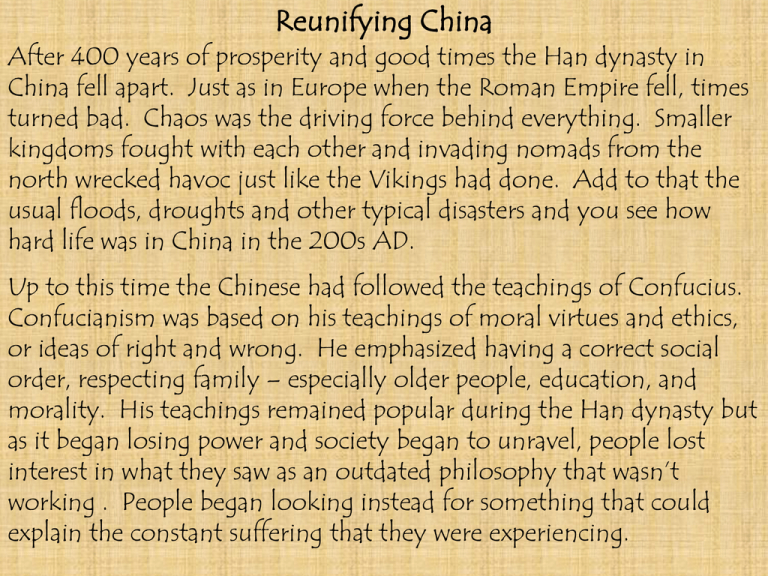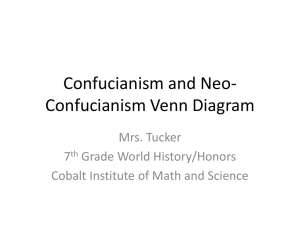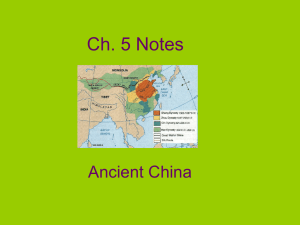Chapter 7 lesson 1
advertisement

Reunifying China After 400 years of prosperity and good times the Han dynasty in China fell apart. Just as in Europe when the Roman Empire fell, times turned bad. Chaos was the driving force behind everything. Smaller kingdoms fought with each other and invading nomads from the north wrecked havoc just like the Vikings had done. Add to that the usual floods, droughts and other typical disasters and you see how hard life was in China in the 200s AD. Up to this time the Chinese had followed the teachings of Confucius. Confucianism was based on his teachings of moral virtues and ethics, or ideas of right and wrong. He emphasized having a correct social order, respecting family – especially older people, education, and morality. His teachings remained popular during the Han dynasty but as it began losing power and society began to unravel, people lost interest in what they saw as an outdated philosophy that wasn’t working . People began looking instead for something that could explain the constant suffering that they were experiencing. Buddhism was the religion that fit the needs of the people in China after the fall of the Han. Buddhism began in India and was based on the teachings of Siddhartha Gautama. He was known as the Buddha which meant “the Enlightened One”. His teachings were popular in China because he taught the following principles: -Suffering is part of life -People suffer because they are too attached to material possessions and selfish ways -People can escape suffering by leading wise, moral and thoughtful lives. Buddhism spread from India to China, Japan and Korea. By the 600s Confucianism was making a comeback but it had undergone changes due to other teachings that had mixed with it. Daoism, a belief system that seeks harmony with nature and with inner feelings, and Buddhism had both caused changes in Confucianism. According to this new mix of ideas morality was the highest goal a person could reach, and it was attained through education. Education came not only by reading books but also by observation or interaction with other wise people. Unifying a bunch of kingdoms that are all fighting with each other for power requires one group to become powerful enough to take over all the others. That usually requires a certain amount of brutality. Yang Jian began the Sui Dynasty by first killing the heir to the Zhou throne, it just happened to be his grandson. He then killed anyone who could claim the throne. He declared himself emperor of the Sui then became known as Wendi. With such a brutal beginning it may be surprising that he became a great administrator. People were allowed to follow their own beliefs but many were put to work on rebuilding the Great Wall and the Grand Canal where almost half of them died. His dynasty only lasted for 37 years. People got tired of paying the high taxes to pay for the wall and canal and they revolted. The Sui Dynasty didn’t last long but it became the foundation for the next great dynasty, the Tang. The Sui Dynasty was a good example of how the Cycle of Chinese dynasties works. The Tang Dynasty started in 618 and lasted for almost 300 years. They expanded China’s borders and the network of roads and canals to help unify all the territories. Tang emperors used Confucian ideas to run the government and became one of the most advanced governments of their time. Taizong helped found the Tang Empire then took the throne after killing his brothers and all their sons. Even so he became known as fair and just leader (to people who weren’t related to him). In 690 Wu Zhao became China’s first and only woman emperor. She ruled for 15 years and reconquered Korea. Another great emperor during the Tang period was Xuanzong, who ruled 40 years. During that time Chinese art and literature became the stuff that the Tang is best remembered for. Public works projects Restored old political traditions Rebuilt parts of the Great Wall and Grand Canal Freedom of worship Civil service exam Reunification of China Confucian ideas of how government should operate Expanded borders Network of roads and canals











